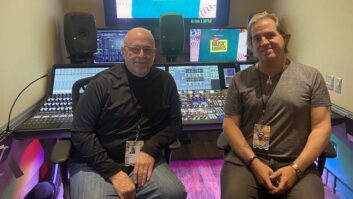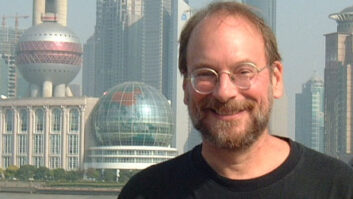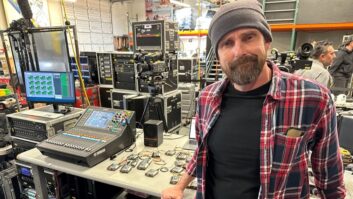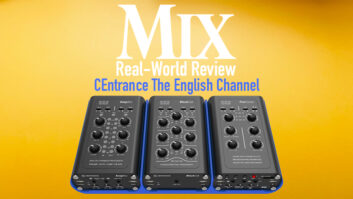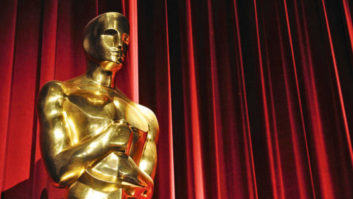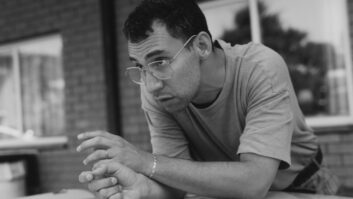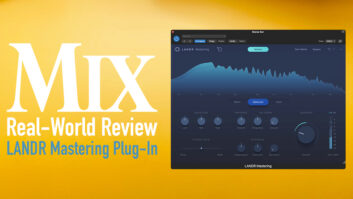It isn’t often that I can, in the space of a few days, learn about anew application of digital technology in audio, connect with a part ofthe audio industry I left long ago, find out more ways our so-calledgovernment has been screwing up, find out why consumer electronicsmanufacturers are not necessarily our friends and fall in love with apiece of retro gear. And, I didn’t even do all of this in my studio; Idid it in my kitchen.
I live in Boston, which, besides being one of the great universitytowns of the world, is a great radio town. That’s not a coincidence;almost every college around here, large and small, has an FM radiostation. Most of them are down in the noncommercial part of the band,from 88.1 to 91.9 MHz. Some are big boomers, like Boston University’sWBUR, which has a large paid staff and is a major outlet for NPRprogramming, but it has little to do with the college itself. Othersare relative pipsqueaks, run by students or volunteers, like TuftsUniversity’s WMFO or Boston College’s WZBC. Harvard’s station, WHRB, isactually a commercial operation; it’s run by undergraduates, but itsells advertising to augment its budget and broadcasts in thecommercial part of the band. The biggest gun in the noncommercial bandis WGBH-FM (where, full disclosure dictates, I have helped produce afew shows and Webcasts), which is part of a nonprofit conglomerate thatalso contains two television stations, several production companies anda bunch of other divisions that make it one of the most successfulentities in American public broadcasting.
The variety that these stations provide to listeners is, as far as Ican tell, unparalleled in the country. While commercial FM stationshave devolved, under the feudal leadership of the two remainingcorporations that own the bulk of them, into the habitats ofbottom-feeding shock-jocks and cookie-cutter “alternative”rock and rap, the independent nonprofits at the low end of Boston’s FMband deliver a well-rounded diet of classical, jazz (and I don’t meanKenny G), electronic, ethnic, punk, ambient and real alternativerock, not to mention news from places other than Washington andHollywood, and public affairs programs that actually connect with andeducate their audiences, and aren’t on the air at 5 a.m. on Sunday.
Am I laying it on too thick? Maybe. But as readers of this columnknow, I’ve always been a big fan of radio. Even in the age ofhigh-speed Web access, I still believe radio is the best way to getpeople to listen to music that they haven’t heard yet. And, exposingaudiences to new music sells records, which means that someone isbooking studio time and buying gear, and that’s why we should all beconcerned about what’s been happening to radio.
But that’s a big issue, and I’m going to focus on a smaller one, orat least attempt to. (I may run off a couple of times, try to forgiveand stay with me…)
One of my favorite stations around here is WUMB, which is licensedto the University of Massachusetts Boston. WUMB is the only 24-hourfolk-music station in the entire country. It went on the air about 20years ago, originally using volunteers, and in 1986, hired aprofessional staff. Its transmitter puts out a middling 660 watts ERP(Effective Radiated Power), and it’s at the top end of thenoncommercial spectrum at 91.9, which means it’s jammed right upagainst where much more powerful stations live. The university is on apeninsula jutting out into the Boston Harbor (a beautiful spot that isshared with the John F. Kennedy Library), but the station’s antenna isseveral miles south of there, on a hill in the city of Quincy, atop awater tower.
In recent years, WUMB has been trying to increase its coverage. Butupping its power has never been an option: According to chief engineerGrady Moates, FCC rules won’t allow that because it might causeinterference to stations, both commercial and noncommercial, on nearbychannels. So instead, WUMB has been snapping up other availablelicenses and re-broadcasting the signal from other sites. They now havetransmitters in Falmouth and Orleans on Cape Cod to the southeast, inWorcester to the west and in Newburyport up north near the NewHampshire border. The Orleans station is on the AM band, but Falmouthand Worcester are on the same channel as the Quincy transmitter, andNewburyport is right next door at 91.7.
As I’ve watched this process, I’ve been doing more than a littlehead-scratching. I know from my radio engineering days that one of theworst enemies of FM reception is multipath interference — thesame signal coming to your receiving antenna from several differentdirections, just enough out of phase to cancel each other out.Multipath is especially a problem in urban areas, where the short RFwaves play pinball among the steel skyscrapers. So not long ago, I gotin touch with Moates and asked him, “How do you keep thetransmitters from clobbering each other?” His reply was,“We don’t. They do.”
If WUMB hadn’t grabbed those licenses, however, someone else wouldhave, sooner or later, snatched them up. Moates explained, “Whilecommercial FMs are assigned on a ‘spacing’-only basis,noncommercials are assigned on a ‘contour’ basis.”Determining where a transmitter can be located involves plottingsignal-strength contours on every channel within 600 kHz of the desiredone, as well as plus or minus 10.6 and 10.8 MHz — the value ofthe Intermediate Frequency in superheterodyne FM receiver designs. (Yousee, I retained something from those days!) “A new stationcan then be dropped in, as long as its contours don’t touch similarcontours of any other station in a way that’s prohibited by FCCrules,” he says.
“The Falmouth and Worcester signals were ‘holes’on our frequency near Boston that somebody was eventually goingto file for, and then their signals and our signal would interferebadly in the overlap areas. So we filed for and got these two stationsas a pre-emptive strike.”
WUMB’s three 91.9MHz transmitters, it turns out, are notexactly on the same frequency. “The FCC allows you to beup to 2,000 Hz off-channel,” explained Moates. “One is at91.900088, and another is at 91.899986. If you drive through theoverlap area, your radio is receiving both signals, but they’re almostnever at the same level. So, your radio constantly jumps, and everytime it jumps, you hear a little ‘phht’ of noise. It soundslike multipath, and it is, but instead of multiple reflections, it’scaused by multiple transmitters. It’s the ‘cellular’approach to broadcasting.”
Even more interesting is how they get the audio on the differenttransmitters to line up, so that when your radio goes from one“cell” to another, the music doesn’t skip a beat. “Wesend the program audio to the transmitters as MPEG-2 on a pair of 56kdedicated phone lines,” he told me. “The phone companydoesn’t offer anything between a 56k and a T1 service, which would costus $2,000 a month and we can’t afford that. They may give lines to somenoncommercial stations for free in exchange for promotionalannouncements, but we’re not big enough for them to do that. So theprocessing delay through the MPEG encoders and down those lines isabout a quarter-second.
“Eventide Clockworks developed a special stereo delay for us,which was based on their profanity delay. It doesn’t use bit-ratereduction, like most profanity delays, because we didn’t want to dothat twice. They modified it [from a typical five or 10 seconds] sothat it could go down in increments of half a cycle at 8 kHz. We canset it up to match the line delay so that the audio to all of thetransmitters is phased within 25 or 30 degrees of each other at 5kHz.”
Despite its low power, WUMB has loyal listeners, like me, all overeastern Massachusetts. I live on a hill about 12 miles northeast of thetransmitter: With a good telescope, I could probably see it. And, upuntil about a year ago, I could listen to it on an old Sony cassetteboom-box while I made breakfast. Upstairs in my studio, it’s alwaysbeen nothing but hum and noise, but I’ve attributed that to theenormous amount of RF junk my computers and audio gear generates.(Instead, when I’m working, I listen to it on the Web. It isn’t pretty,but it’s better than the beer and junk food commercials on the stationsthat do make it through the noise.)
Last year, however, the cassette mechanism in the Sony bit the dust.I replaced the boom-box with one of those snazzy, feature-filledCambridge Soundworks CD/FM two-tweeters-and-a-sub systems. It soundedgreat on the commercial band and on the big educational stations, butWUMB nearly disappeared altogether. When I tried to listen to it, I’dget occasional little wisps of guitar or hammer dulcimer, which werequickly buried by distortion and hash. Vowing to reclaim my family’sright to listen to Arlo Guthrie and John Gorka over our morning coffee,I put up a rooftop antenna, and with a map and a compass, I pointed itright at the Quincy transmitter. The noise just got louder. My wifedemanded that we bring back the Sony, broken tape player or no.
It wasn’t the three transmitters that were conspiring against me— I’m far enough from Worcester and Falmouth so that they aren’ta factor. And there’s nothing particularly powerful that’s close to91.9 on the dial that might be blowing it away, so I couldn’t blame iton the new radio’s presumably better sensitivity.
Moates straightened it out for me. In between me and WUMB’s tower,directly in the line of sight, are the two biggest transmitter sites intown: the Prudential Center and the John Hancock building. They arepumping out so much FM, TV (including one almost-unwatched station witha million watts ERP), microwave, taxicab calls and God knows what otherkind of electromagnetic energy that the tuner in this fancy radioliterally can’t pick out that tiny little 660-watt signal from theothers — no matter how far away in the spectrum they are.
“All that RF energy is causing intermodulationproducts,” Moates explained. “When two or more stationshave transmitter sites near each other, they can mix together andcreate additional signals on other frequencies that shouldn’t exist. ByFCC rules, those products are supposed to be at least 80 dB below themain signal [about .01% of the power of the station or less]. But whenyou’ve got ERPs like 50,000 watts, even 80 dB down is still aconsiderable amount of energy, when you compare it to our 660-wattsignal after it’s traveled 10 miles or more. [You can read the actualwording of the rule, if you’re really interested, at the end of this article.]
“Intermodulation can also happen in receivers,” Moatescontinues. “Digital tuners, especially the cheap ones that theyuse in these mini-systems, have varactor diodes in the front-endcircuitry, which tune the radio when a DC reverse-bias voltage isvaried by a microprocessor. When you tune the radio, you’re justchanging this DC voltage.
“But these diodes are easily overloaded, and when they are,they start conducting forward on the high-RF energy, causing the radioto create its own ‘intermodulation’ products. And that’swhy you get all that interference.
“It’s a kind of ‘dumbing-down’ of consumerelectronics. The manufacturers don’t want to let you adjust anything.They’ve even taken out the Mono switch, which you used to be able touse to help receive difficult stations. They’ve replaced it with anautomatic circuit that blends the highs progressively as the signalweakens. What you end up with is a mono signal, but you don’t know thatbecause the ‘stereo’ light is still on!”
That’s also why the old Sony boom-box’s tuner worked: It was analog.It is why the $600 over-powered, over-featured digital receiver in mystudio can’t pick up the station. And, it’s why the ancient Onkyoreceiver in my bedroom can get WUMB most of the time: It’sanalog, too, and it has a really helpful Mono button.
The manager of the Cambridge Soundworks store who sold me the radioadmitted that people don’t buy it for the tuner: “They just buyit for the CD.” Another company that produces a high-end tabletopradio has, said Moates, “this beautiful $300 box, which they puta $9.95 tuner in.” Moates wouldn’t let me quote him saying thename of the company because of their propensity for taking legal actionagainst their critics. (Another source I talked to said he was oncequoted in an article referring to the company as“litigious,” and immediately got a call from their lawyerdemanding a retraction.)
So where besides at an antique store can you get an analog FM radiothat can pull in these valuable and underpowered stations in thisdigital age? Therein lies another tale, which is going to have to waituntil next month.
Paul Lehrman, like a vintage tube, is just getting warmed up.View his latest projects atwww.paullehrman.com.
TITLE47–TELECOMMUNICATION
CHAPTER I–FEDERAL COMMUNICATIONS COMMISSION (Continued)
PART 73–RADIO BROADCAST SERVICES–Table of Contents
Subpart B–FM Broadcast Stations
Sec. 73.317 — FM transmission system requirements.
(a) FM broadcast stations employing transmittersauthorized after January 1, 1960, must maintain the bandwidth occupiedby their emissions in accordance with the specification detailed below.FM broadcast stations employing transmitters installed or type acceptedbefore January 1, 1960, must achieve the highest degree of compliancewith these specifications practicable with their existing equipment. Ineither case, should harmful interference to other authorized stationsoccur, the licensee shall correct the problem promptly or ceaseoperation.
(b) Any emission appearing on a frequency removed fromthe carrier by between 120 kHz and 240 kHz inclusive must be attenuatedat least 25 dB below the level of the unmodulated carrier. Compliancewith this requirement will be deemed to show the occupied bandwidth tobe 240 kHz or less.
(c) Any emission appearing on a frequency removed fromthe carrier by more than 240 kHz and up to and including 600 kHz mustbe attenuated at least 35 dB below the level of the unmodulatedcarrier.
(d) Any emission appearing on a frequency removed fromthe carrier by more than 600 kHz must be attenuated at least 43 + 10Log10 (Power, in watts) dB below the level of the unmodulated carrier,or 80 dB, whichever is the lesser attenuation.
(e) Preemphasis shall not be greater than theimpedance-frequency characteristics of a series inductance resistancenetwork having a time constant of 75 microseconds. (See upper curve ofFigure 2 of Sec. 73.333.)
Grady Moates adds: This is a change from earlier years. …noticethat there is no “minimum” pre-emphasis. This means that a stationcould, if it so desired, operate flat. Hmmmmm….

